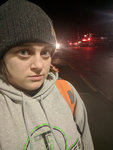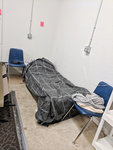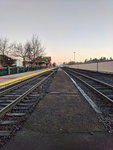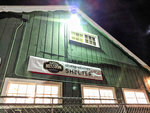



As an editorial columnist for The Chronicle, I feel like I have an appreciation for perspectives. I’m always exploring other people’s opinions and finding new ways to put myself in other people’s shoes. And I feel a strong sense of responsibility to educate myself first-hand when I want to write about a given topic.
When I floated the idea of spending a night as a homeless individual at the Hub City Mission Severe Weather Shelter, I definitely got some skeptical responses. Many worried for my safety. But knowing this was a path that people walked every day in our community — a path that I had little first-hand experience with — I remained determined to make the experience a reality.
I contacted staff at the Hub City Mission in the days before my stay. I wanted to ensure that, by taking on this experience, I would not be depriving another person in need of bedspace. Josh Gerhing, Hub City Mission Director, graciously responded and outlined the rules that I should follow — both as a journalist and individual — while at the shelter (i.e. no photos of patrons’ faces, etc.).
Last winter, I had been critical of the decision to move the severe weather shelter operations to the fairgrounds. I feared that a lack of infrastructure — sidewalks and the like — created safety concerns for those traveling to and from the shelter. The fact that Twin Transit bus service stopped around 6 to 6:30 p.m. also compounded transportation logistics to and from the shelter.
I wondered if I didn’t use my platform as a writer to advocate for those in our community without a voice, who are largely unheard and unseen (let alone taken seriously) ... who would?
So it seemed only fair to the Mission, in light of my previous criticism, to use the opportunity to “put my money where my mouth is,” so to speak.
To recreate the experience, I decided to walk from the Centralia Train Depot to the fairgrounds, as if I were a homeless person traveling from, for instance, OPEN ARMS weekly serve event or maybe from the Gather “Eat Free” Cafe, as a local homeless person might do.
I packed an orange backpack for safety — to increase my visibility while walking — with some extra clothes, my phone charger, granola bars and some other survival type tools. I dressed in layers, wearing two pairs of leggings under worn out, too-big-for-me black jeans, and a dirty light grey hooded sweatshirt and grey stocking cap. I chose some dusty worn work boots to complete the ensemble.
I left my car at the Centralia Train Depot and walked over to the Hub City Mission’s location on Tower. Their doors were open and volunteers were standing outside. As I walked by, I could sense their eyes on me. They saw the dirty clothes, the backpack, how I avoided their eye contact. They suspected I was “in need.” I sensed they wanted to invite me in, but I think they worried they might offend me if I wasn’t, in fact, in need. I kept walking.
From there, I headed south towards Chehalis. It’s 2 miles between downtown Centralia and the Fairgrounds. I knew from walking on the treadmill that I could comfortably pace 3 miles per hour, so I figured it’d take me about that long to get there.
Walking through downtown Centralia wasn’t a big deal, although I was very aware of the eyes upon me as I navigated through Centralia’s Friday evening nightlife scene. I felt the avoidance and heard the hushed whispers. I’d be lying if I said I didn’t feel the urge to say something to onlookers like: “Look, I’m not really homeless, okay?”
As I approached the viaduct, I knew I was approaching the darkest stretch of the whole journey. No matter which option you choose — South Tower, South Pearl, or Gold Street — none of the paths are particularly well-lit the entire way.
As I made my way through the South Tower and South Pearl neighborhood, I was spooked a couple of times as figures emerged from the shadows between dim street lights. Uneven sidewalks turned to gravel edges in some places. The trek from South Pearl back to Kresky was particularly dark.
If someone who couldn’t take a bus because, say, they’re pushing a shopping cart or a stroller, or on a bike with a trailer, it would be difficult to navigate in the dark even with a light source. But it’s doable. For those with disabilities or in wheelchairs it might be another story, though.
Once I made it back to Kresky Avenue, I had a decent sidewalk the whole way to the Fairgrounds (heading north from Chehalis is a different story entirely).
Upon arriving at the Fairgrounds at the Green Gate, I happened upon a closed entrance. I checked the time — 7:30 p.m. — so the shelter should have been open. After a few moments, a strange man appeared and said: “Are you ready?”
I gathered this man was a volunteer.
Once I walked down the entrance steps, I was led to a table with storage bins next to a large DRY BOX storage container. I was instructed to empty my pockets and write my name on a piece of duct tape. They stuck my name to my backpack and put it in the storage locker without even telling me what was happening. I was then instructed to hold out my arms so that I could be wanded with a metal detector and checked for weapons.
As I put my phone and other items back in my pockets, they pointed me towards the 4H building. They didn’t really tell me where to go, but the shelter area was completely fenced in such a way that you were led around the side of the building to the main entrance.
I fumbled with the door. It was stuck. A stranger quickly came to the door.
“You gotta turn it up,” he said, turning the french handle.
I walked in the door to a common space. There was a large area rug on the concrete floor next to a small leather couch, a couple of tables with chairs, and a few cots. There was a kitchen area adjoining one side and a table set up with coffee, tea, cocoa, Cup o’ Soup and Goldfish crackers.
A volunteer motioned for me to sit down at one of the round tables and asked for my name. She took my information and wrote it down on a page in a three-ring binder. She asked me what bed I wanted and I said I didn’t care. She suggested bed number one and I accepted. Another volunteer then handed me a pillow and a tan drawstring sack.
The women’s space was visible from the common space through a doorway. I stepped down into the space and set my pillow and drawstring sack on the army green cot with the number “1” taped above it. There were six cots set up in the room and a carpet remnant duct taped to the uneven concrete floor. Two beds were occupied already by other women — one in her 30s and another in her 40s.
My tan drawstring sack contained a flat top sheet and a dark plaid wool blanket. I pulled the folded up blanket out of the bag, set it on the bed and sat down.
The two women who were already there knew right away that I wasn’t a regular. They were immediately curious. I was transparent, telling them that I was a writer — a columnist, not a reporter — who wanted to explore what it was like to stay at a shelter as a homeless person.
I generally consider honesty to be the best policy, but I was really trepidatious in sharing this information. I was afraid that these women would feel like I was treating their lifestyle like a vacation — that I was trivializing their daily reality.
But the two women — good friends as it turns out — welcomed me with incredible warmth, openness and authenticity.
As we sat on our cots getting to know each other, a gentleman named Julien from the Housing Resource Center came into the room. He greeted us and asked if it was okay for him to sit down and we approved.
Julien began to go through an exhaustive questionnaire process with each of the women. Their responses were, at times, heartbreaking. Both women indicated that they had been in foster care at some point during their childhood. Both women indicated they had experienced a physically abusive environment at various stages of their lives. Both women had used hardcore drugs in the past. Both had become homeless after leaving abusive partners. The woman in her 40s had recently miscarried. The woman in her 30s was three weeks postpartum and had given birth 10 weeks early. Her son was in the NICU all the way down in Vancouver.
The woman in her 40s who had recently miscarried had been assaulted by her partner and locked out of their shared camper. She said she hadn’t slept in three nights, because the severe weather shelter hadn’t been open the last three nights — that she had to walk around at night to stay warm (and alive). Her blistered bare feet showed obvious signs of wear and overuse.
Julien from the Housing Resource Center asks the woman in her 40s if she has anything in life that makes her feel “fulfilled.”
“Feeding the ducks ... I love feeding the ducks,” she replies.
The woman in her 30s was a former heroin addict. She had already surrendered four children to CPS born while she was in a relationship with a physically abusive, heroin-addicted partner. She didn’t feel worthy of being a mother while she was addicted to heroin. She finally left her abusive partner and got clean, recently giving birth to her fifth child — a son — with a new partner. Now that she was clean, she was planning to raise her son with her partner.
When she went into premature labor at 30 weeks, she was transferred to Vancouver. For the past three weeks, she had been living on the streets in Vancouver, returning to the hospital to pump breastmilk for her premie infant son while he was in the NICU. She had just found out that her son was going to be discharged from the hospital on Monday.
And she had just found out that same day that CPS would be taking custody of her son upon his release from the hospital, despite the hospital advocating and vouching for her level of parental care while staying with her son.
CPS was following policy. Normal procedure. But it was nonetheless heartbreaking, speaking as a mother myself.
She felt frustrated. Trapped in a system that felt like the deck was always stacked against her. At the base of an uphill battle. She was struggling to find transportation back to Vancouver to see her son before he was discharged.
But she was grateful that her son was going to a familiar foster home with one of his half siblings. A foster parent that she had a good, communicative relationship with.
At one point, the woman in her 40s saw me lying on the bare cot and offered to make my bed for me. I was struck by her generosity. She knew that I was privileged and yet seemed to want to “mother” me. And despite her pain while getting around.
I graciously accepted her offer.
Both women I was bunked with had served multiple stints in jail. As the woman in her 40s made my bed, taking care to lay the sheet and even getting me an extra blanket and pillow, she explained to me that she was frequently “pod mom” when she was incarcerated at the Lewis County Jail — that she was always the person helping others get acquainted with their environment.
As I inquired more about her jail experiences, she told me that she had seen people on the street who were so cold, that they broke windows on purpose, just so they could be arrested and go to jail … just so they could be warm.
After my bed was made, we went out to the common space. Another patron was a man dressed in new Carhartt pants and nice boots. This was when I learned that some of the people at the shelter were employed, but didn’t make enough to secure housing, so they lived in their cars. But on nights that the shelter was open, they appreciated a warm, flat bed.
I lent him my Zippo lighter.
Everyone shared everything at the shelter. Everyone was willing to serve one another. The woman in her 40s cut up her “Tiger Balm” patches to share and was letting other people color in some of her coloring pages with the gel pens she traveled with.
10 p.m. meant lights out, so we relocated back to our cots. The cots are firm and noisy, but definitely adequate. I was grateful for the second blanket. Through the night, I could feel the chill circulating from the underside of my cot. It was difficult to sleep throughout the night as people moved about.
When I opened my eyes at 5:30 a.m., I decided it was time to get up for the day. I had a two mile walk back to my car. I started getting ready. It was lights on by 6 a.m. anyways — the shelter closes for the day by 7 a.m. There was instant oatmeal, granola bars and coffee available.
Restrooms were located in the building directly across from the 4H building, and included showers, too. The restrooms weren’t heated, but I was still wearing my same three layers of clothing. I decided against taking a shower (since I had the luxury of going home to a house).
When I returned to the shelter, I asked what everyone was gonna do next. The two women I was bunked with were waiting for bus passes and the first bus to the Hub City Mission on Tower for breakfast, then heading to Gather’s Eat Free Cafe for brunch before they closed (Gather doesn’t always serve on Saturdays, so they wanted to take advantage of the extra meal).
They also mentioned that Lenny from the Gather Cafe — who I’ve interviewed previously — often would give people rides between the shelter and Gather Cafe. Patrons of the shelter tell me that, between willing volunteers, and Twin Transit’s new, extended hours for the Intercity Express and the Sunday Express, that there has been an increase in accessibility to and from the shelter. Residents are able to get a ride from the Centralia Train Depot as late as 8:30 p.m. to reach the shelter by 9 p.m. with a bus pass or $1.
I regret how I left things. I told the two women I had bunked with that I would meet them at the Hub City Mission on Tower because I didn’t want to wait for the bus, but I was also afraid to say goodbye. I wasn’t sure how to say “hey, guess what? I’m going back to my real life to eat bacon in my warm house that I own with my husband and kids.”
I was, in a way, ashamed of my privilege, in that moment. But I wish I would have said “thank you” again and “goodbye.” I hope if they happen upon this article, that they feel like I did them justice in print.
I walked out the green gate from the fairgrounds just as the dark was turning to daylight. I took the Gold Street route back to my car — another 2 mile trek. I ended up with a blister on each foot from taking the trek in work boots … and I had only been “homeless” for about 12 hours.
I arrived back at the Centralia Train Depot just as the last bits of pink were fading from the morning horizon line.
When I arrived back at my car, I realized that another homeless individual had parked next to me overnight and weathered the frosty night in his truck right there in the parking lot.
Homelessness is everywhere we look these days — and few real solutions are in sight. The increase in visibility continues to underscore the need for exactly what the Hub City Mission is providing.
And with that thought, I started my car and drove back to my ridiculously privileged life.
Money Raised During My Shelter Stay: $240
Shelter Growth 2016-2018
2016: Hub City Mission Shelter on Tower — 19 men, 6-8 women
2017: Hub City Mission Shelter in Pacific Mobile Portables at SWWA Fairgrounds — 23 men, 15 women
2018: Hub City Mission Shelter in 4H Building at SWWA Fairgrounds — 30 men, 8-10 women + common / living space
Shelter Stay Stats
2016: 2,760 stays 2017: 1,965 stays
Connect and Get More Info
Hub City Mission on Facebook — shelter operation updates, shelter requests, volunteer orientation opportunities
Hub City Mission at Bethel-Church.com — 2018 shelter update from HCM Director Josh Gerhing, contact form, volunteer opportunities, more info on food pantry, table ministry, etc.
Those interested in donating to the project can mail checks to 132 Kirkland Road, Chehalis, or go online to bethel-church.com/give (please specify the funds are for the shelter). Volunteers are also being sought to staff the shelter. Some of the most sought-after donated items include toiletries, laundry supplies, non-perishable food and cash. To inquire further about donating items or time to the shelter, visit bethel-church.com/hcm. To volunteer, check out the Facebook page “Hub City Mission” or email hubcitymission@bethel-church.com.